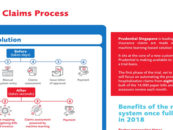
Tokio Marine Life Insurance Singapore Ltd. Launches Self-Learning Chatbot To Simplify Insurance For Public
by Company Announcement October 3, 2017Tokio Marine Life Insurance Singapore Ltd. (TMLS), the only Japanese life insurer in Singapore, today launched the first self-learning AI chatbot in Singapore that makes life insurance easier to understand and more accessible for the public.
Available 24/7 on popular messaging app Facebook Messenger, the chatbot, named TOMI (for Tokio Marine Insurance), builds on the success of an earlier version released in January when TMLS became the first financial institution in Singapore to launch a chatbot for its financial advisers.
The current version is aimed at empowering the public to understand and manage their insurance coverage more independently by providing users with instant and accurate explanations of commonly-used terms in insurance, information on TMLS products and solutions, and how to join the industry as a financial adviser with TMLS.
“TOMI represents our vision on the future of Singapore’s life insurance sector,”

James Tan
said James Tan, Chief Executive Officer of TMLS.
“Conversations play an important role in how a customer buys and consumes life insurance products. As customers’ behaviour shift towards digital, we see intelligent AI-powered chatbots as a natural evolution of websites and mobile apps, and will eventually become a dominant digital channel in how a customer interacts with an insurer.
“Customers are at the core of our business, and we aim to empower them in making well- informed decisions on their financial planning and insurance coverage. We are confident that TOMI will be a useful tool that prepares them to have more meaningful, well-informed discussions with their financial advisers on their relevant insurance needs,”
he said.
TOMI marks a milestone for TMLS in its digitisation journey, which was inspired last year by Prime Minister Lee Hsien Loong’s call to action on the Smart Nation initiative. The move towards digitisation is supported by regional headquarters Tokio Marine Asia (TMA), which will be exploring the potential extension of TOMI and its functionalities to other regional markets in Asia.
![]() The technology behind TOMI is called Deep Learning for Natural Language Processing, or Deep NLP in short. Compared to the traditional NLP approach which only interprets short phrases and sentences, Deep NLP can interpret sentences regardless of length and grammatical accuracy. This capability allows TOMI to understand grammatically inaccurate sentences and even Singlish. This sets TOMI apart from many other chatbots, which rely primarily on keyword recognition or require grammatical accuracy from users.
The technology behind TOMI is called Deep Learning for Natural Language Processing, or Deep NLP in short. Compared to the traditional NLP approach which only interprets short phrases and sentences, Deep NLP can interpret sentences regardless of length and grammatical accuracy. This capability allows TOMI to understand grammatically inaccurate sentences and even Singlish. This sets TOMI apart from many other chatbots, which rely primarily on keyword recognition or require grammatical accuracy from users.
Built in collaboration with home-grown AI startup Pand.ai, TOMI signifies TMLS’ ongoing commitment to support the local financial and insurance technology ecosystem, by partnering local small and medium enterprises (SMEs) to build locally relevant products and services for the Singapore market.
Chuang Shin Wee
“We are proud to partner a Tier-1 insurer like TMLS to bring our proprietary AI technologies to the insurance space,”
said Chuang Shin Wee, Co-founder and Chief Executive Officer of Pand.ai.
“We are very excited about the launch of TOMI for the public, and look forward to bringing more AI technologies from our research laboratories to the market.”
TOMI can be accessed via the following methods:
- On the Facebook Messenger mobile app, by searching “Tokio Marine Singapore”;
- On the Facebook page, by typing “Tokio Marine Singapore” in the search bar and starting a chat via the “Message” button; or
- On the Tokio Marine Singapore website, by clicking the TOMI icon on the Tokio Marine Life Insurance page.
- On the Facebook Messenger mobile app, by scanning Tokio Marine Singapore profile code
-
- o To scan, users can click on their profile picture to access the “Me” page. On this page, users should click on their profile picture again to open the code scanner.
-








